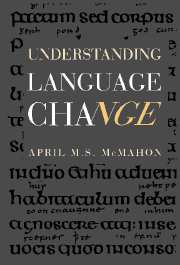Book contents
- Frontmatter
- Contents
- Preface and acknowledgements
- 1 Introduction
- 2 Three views of sound change
- 3 Sound change 2: the implementation problem
- 4 Morphological change
- 5 Syntactic change 1: the Transparency Principle
- 6 Word order change and grammaticalisation: language change and general laws
- 7 Semantic and lexical change
- 8 Language contact
- 9 Linguistic variation
- 10 Pidgins and Creoles
- 11 Language death
- 12 Linguistic evolution?
- Bibliography
- Index
7 - Semantic and lexical change
Published online by Cambridge University Press: 05 June 2012
- Frontmatter
- Contents
- Preface and acknowledgements
- 1 Introduction
- 2 Three views of sound change
- 3 Sound change 2: the implementation problem
- 4 Morphological change
- 5 Syntactic change 1: the Transparency Principle
- 6 Word order change and grammaticalisation: language change and general laws
- 7 Semantic and lexical change
- 8 Language contact
- 9 Linguistic variation
- 10 Pidgins and Creoles
- 11 Language death
- 12 Linguistic evolution?
- Bibliography
- Index
Summary
Introduction
One of the quickest and easiest ways of introducing a sceptical non-linguist to the fascination (if not the relevance) of historical linguistics is to mention some titbit of information like the fact that silly used to mean ‘blessed’; that the word blurb was invented (by the American humourist Gelett Burgess) in 1907; or that lobster and locust were both borrowed into English from the same Latin word. All three nuggets of information relate to the lexicon, the repository of words and meanings in a particular language. Changes in meaning and in lexical inventory tend to have a higher profile among native speakers than other types of change, as witness letters to the British press denouncing ‘Americanisms’, and the attempts of the Académie Frangaise to regulate the influx of English loans into French, to give just two examples. This does not necessarily mean that historical linguists have been particularly successful in accounting for such changes, as we shall see in 7.2, when we attempt to ascertain how semantic changes in the meaning of existing words might be classified and explained. The rest of this chapter deals with lexical creativity, or the formation of new words using a language's own resources, including productive morphological processes and compounding. In Chapter 8, we turn to lexical borrowing, or the introduction of new words from other languages, and to the general issues of external motivation for language change, and the broader consequences of language contact.
- Type
- Chapter
- Information
- Understanding Language Change , pp. 174 - 199Publisher: Cambridge University PressPrint publication year: 1994



